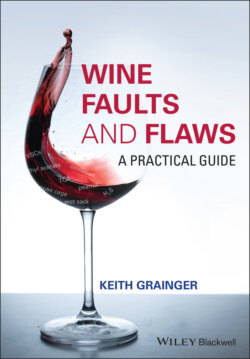Читать книгу Wine Faults and Flaws - Keith Grainger - Страница 73
2.6.3.4 Aroma Characteristics
ОглавлениеSome older tasters, and wine writers, distinguish between the terms ‘aroma’ and ‘bouquet’. They use the term ‘aroma’ when referring to the primary aromas derived from the grapes. ‘Bouquet’ would encompass the assembled characteristics resulting from changes that have taken place during fermentation (secondary aromas), and particularly maturation and ageing (tertiary aromas). The distinction is far from clear‐cut, and as such, the words ‘aroma’ and ‘odour’ are used in this book as all‐encompassing terms.
There are some 800 or more volatile compounds that have been identified in wines, in concentrations ranging from a few nanogrammes to hundreds of milligrammes per litre. The olfactory perception thresholds of odorous compounds vary from 4 pg/l, to 100 mg/l, but the sensory threshold for any individual compound may differ when present with other compounds. It is even possible that some compounds may be detected at concentrations of a few femtogrammes per litre (fg/l).
There has been considerable research over the last couple of decades into the identification of the individual compounds (and their precursors) that contribute to wine aromas. These activities are still in their infancy. Table 2.3 lists some of the compounds contributing to individual aromas, including their origins and typical odour detection thresholds. The Sauvignon Blanc variety has been particularly well studied in respect of the precursors, development, and reactions of volatile thiols in the grapes, must, and wine, as reviewed in 2012 by Coetzee and du Toit [10]. The aromas commonly found in a young wine made from Sauvignon Blanc, and the volatile thiols that responsible for these aromas, are shown in Table 2.4.
Table 2.3 Some compounds responsible for wine aromas, their origins, aroma descriptors, and typical sensory detection thresholds.
| Compound | Aroma descriptors | Sensory detection thresholda) |
|---|---|---|
| Primary aromas | ||
| Terpenes | ||
| Wine lactone | Lime, coconut, wood, sweat | 10 ng/l |
| Linalool | Floral, rose, lavender ‘Muscat’ grape | 25 μg/l |
| Geraniol | Geranium, rose, citronella | 30–130 μg/l |
| Nerol | Rose | 200–300 μg/l |
| α‐Terpineol | Lily of the Valley, spice | 250–400 μg/l |
| Citonellol | Citronella | 18–100 μg/l |
| Cis‐Rose oxide | Lychee, rose | 100–200 ng/l |
| Trans‐rose oxide | Rose | 80 μg/l |
| 1,8‐Cineole (eucalyptol) | Eucalyptus | 3.2 μg/l |
| N.B. Over 50 terpenes have been identified in grapes | ||
| Secondary (fermentation) aromas | ||
| Esters | ||
| Ethyl acetate | Pear drops, solvent, nail varnish remover (levels above 100 mg/l may regarded as a fault) | 3.6–13 mg/l |
| Ethyl propanoate | Cherry | 2.1 mg/l |
| Ethyl‐2‐Methylpropanoate | Strawberry, banana | 1.8 mg/l |
| Ethyl hexanoate | Green apple, aniseed | 14–140 μg/l |
| Ethyl octanoate | Meat fat | 5 μg/l |
| Ethyl Decanoate | Floral, grape | 200 μg/l – 1.5 mg/l |
| Ethyl butanoate (ethyl butyrate) | Pineapple | 20–400 μg/l |
| Ethyl isovalerate | Fruits | 3 μg/l |
| Isoamyl acetate | Banana | 30 μg/l – 2.7 mg/l |
| Hexyl acetate | Pear | 2.4 mg/l |
| Phenylethyl acetate | Rose, honey | 250 μg/l – 6 mg/l |
| 2‐Phenylethanol | Floral | 20 mg/l |
| Alcohols | ||
| Ethanol | Alcohol! | 100 mg/l |
| 2‐Phenylethyl alcohol | Rose, lilac | 14 mg/l |
| Isoamyl alcohol | Malted barley, Whisky | 30 mg/l |
| 1‐Hexanol | Cut grass | 4.5 μg/l |
| Wood (maturation) aromas | ||
| 2‐Furfurylthiol | Roasted coffee | 4 pg/l |
| Furfural | Almond | 20 mg/l |
| Eugenol | Clove, spice | 500 μg/l |
| Trans‐Nonenal | Sawn wood | 250 ng/l |
| cis/trans‐Whiskylactone | Coconut | 125 μg/l |
| Guaicol | Smoke | 75 μg/l |
| Vanillin | Vanilla | 200–320 μg/l |
| Maltol | Caramel | 30 μg/l |
a) Sensory detection thresholds depend upon many criteria, including the presence of other compounds and the wine matrix. The figures stated have been extrapolated from numerous sources.
Table 2.4 Compounds contributing to the varietal aromas of Sauvignon Blanc wines.
| Aroma | Thiol | Sensory detection thresholda) |
|---|---|---|
| Boxwood – broom, cat's pee | 4‐Mercapto‐4‐methylpentan‐2‐one | 0.8–3.3 ng/l |
| Citrus zest and peel | 4‐Mercapto‐4‐methylpentan‐2‐ol | 55 ng/l |
| Grapefruit, passion fruit | 3‐Mercaptohexan‐1‐ol | 60 ng/l |
| Mango, guava, passion fruit | 3‐Mercaptohexyl acetate | 4 ng/l |
| Cut grass | 1‐hexanol | 4.5 μg/l |
| Smoke, gunflint | Benzenemethanethiol | 0.3 ng/l |
| Aroma | Methoxypyrazine | Sensory detection threshold a) |
| Green pepper, grass | 2‐methoxy‐3‐isobutyl pyrazine (iBMP) | 1–2 ng/l |
a) Sensory detection thresholds depend upon many criteria, including the presence of other compounds and the wine matrix. The figures stated have been extrapolated from numerous sources.
It may sometimes be helpful for the taster to consider wine aromas in basic groups:
Fruits (primary aromas);
Flowers (primary aromas);
Spices (primary, secondary, and tertiary aromas);
Vegetables (primary and tertiary aromas);
Oak aromas (secondary aromas);
Other aromas.
Of course, it is possible to divide each of these basic groups into subgroups. For example, the fruits group might be divided into citrus, green, red, stone, and tropical fruits. Dried fruits may also be included. Each subgroup contains individual aromas and flavours.
All aromas detected during nosing should be noted, and when detailing individual descriptors, these may be linked to known varietal characteristics. For example, green apple, lime, peach, and mango are just some of the aromas that may be associated with Riesling. Strawberry, raspberry, red cherry, green leaf, and mushroom are typical aromas associated with Pinot Noir. The detection of any oak related aromas including vanilla, toast, nuts, and coconut may warrant interpretation (barrels/beans/chips?).
